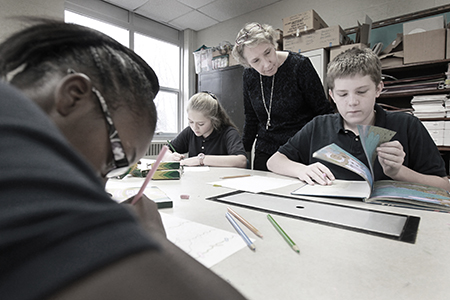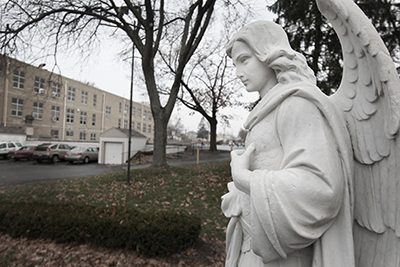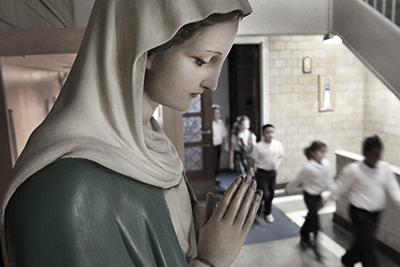Karyn Hecker became principal of Dayton’s Immaculate Conception School in 2006, the first year that Ohio offered vouchers to defray the cost of private-school tuition for families wanting to escape failing public schools.

The decision to accept voucher students was driven mainly by the close-knit parish’s determination not to let its school, which mostly serves low-income children, go under. It came at a time when Catholic dioceses were aggressively merging and closing schools across the country, especially in inner cities, and Dayton’s Catholic schools were among those experiencing an emotionally wrenching downsizing.
Hecker knew what an infusion of voucher students—and the public money they’d bring—would mean to a school on the financial brink. She had been principal at Dayton Catholic Elementary, an inner-city Catholic school that had recently closed. She came to Immaculate “pretty angry and very hurt” that she had been forced to shutter a school that she believed was a lifeline for poor, African American children. What worried her was that she might have to do it again.
Moreover, Immaculate’s precariousness was personal to the dogged, straight-talking Hecker. She had attended the school as a child—when it served almost five times as many students—and she was married at the parish church.
In the seven years since Immaculate introduced vouchers, it has become increasingly dependent on the program for the revenues that enable it to educate its pupils. In 2012–13, almost three-quarters of the school’s 207 students received EdChoice Scholarships. (In 2013–14, 171 students received these vouchers.)
Without the voucher, many of those students could not have afforded the school’s $4,300 tuition—or even the discounted fee of $2,550 that parish members pay.
Today, the K–8 school has enough students to support one class for each grade. It’s trying to create a pupil pipeline by leasing four classrooms to the local Head Start program. Last year’s (2012–13) Kindergarteners were the biggest voucher class in the school, with twenty-nine out of thirty youngsters receiving a grant. The eighth-grade class had fourteen students, six of whom received vouchers.
* * *
Not everyone at Immaculate supported taking vouchers or welcoming more poor, non-Catholic children, virtually all of whom were fleeing a troubled public school in Dayton.
But the sixty-seven-year-old Hecker, who has worked in Catholic education for thirteen years, had no patience for the objections.
“You can’t conduct a ministry without money,” she said.
All agree that the admission of voucher students has changed the East Dayton neighborhood landmark. The school has far more poor students today than it did before it began to participate in the EdChoice Scholarship program. Seven years ago, about a third of the school’s students were eligible for free and reduced-priced lunches. Now, 75 percent qualify.
Academics are a greater challenge, too, as many of these new pupils are well behind when they arrive at Immaculate. Mollie Mallin, an eight-year veteran who teaches math, science, and religion to fourth and fifth graders, said, “The first two or three years—as teachers—we noticed the biggest change.”
Hecker, however, demanded that “we not dumb down the curriculum,” Mallin said. Her principal insisted that the school still had gifted children, arguing that teachers just “may not recognize them.”
Mallin said she notices that many of her students’ parents aren’t able to help with homework. “We don’t assign as many projects that involve going to the library,” she said. “We supply the resources in the classroom.”
Gaile Beale, who volunteers at the school three days per week, retired in 2006 from Immaculate after teaching there for thirty-eight years. The school, she said, can’t count on the volunteers it once had. Fathers no longer run the fish-fry fundraisers, for example, and mothers are too swamped to help in the classroom.
Sandy Beall, an art and physical-education teacher whose three children attended the school, said vouchers are only part of the explanation for the changing face of Immaculate. Though some middle-class families did leave because of the influx of poorer students, she said the school’s demographics had been changing for years.
Residents started leaving the historically white, blue-collar Belmont neighborhood in the 1970s with Dayton’s adoption of busing for desegregation. The exodus has continued with the city’s hemorrhaging of manufacturing jobs and population.
Beall said some parishioners were concerned about accepting vouchers because many of the new students were certain to be non-Catholic, and church members feared the school would lose its religious identity. She thinks that has turned out to be a non-issue because the school still does “everything we used to do.” Religion is taught daily, and children attend Mass or prayer service once a week.
Yet, Catholicism is taught more than it is preached. “It’s not our job to convert people,” Hecker said. “That’s God’s job. Our job is living it [the church’s teachings].”

Father Satish Joseph, associate pastor of Immaculate Conception, estimates that twenty-five to thirty families left the school the first year that vouchers were accepted, with enrollment falling to 190 students the second year. He said some critics didn’t want the school “downgraded from its glorious past” but acknowledged that, from a financial perspective, the decision was a “no-brainer.”
Because of vouchers, he said, the church—which serves about 800 families—has cut its subsidy to the school by more than half. Now the parish kicks in about $75,000 annually for the school.
If the EdChoice program is ever eliminated, Joseph said, “I can see four schools—including ours—in our neighborhood closing….We’ve now become dependent.”
Hecker bristles when she recalls that some families left because “we were going to take ‘those children,’” which she interpreted to mean poor, African American kids.
“Those are fighting words in our school,” she said.
Lori Wolff’s son attended Immaculate from preschool through eighth grade and now attends Archbishop Carroll High School. She “knew a lot of the people who left” when the parish began accepting vouchers, but she stayed because she believed “we were supposed to be open to everybody.”
A Kettering resident, Wolff was not eligible for a voucher. “It would have been nice to have it,” she said, but she doesn’t think it was unfair that she didn’t get the benefit.
* * *
In addition to administering the Ohio Achievement Assessments (OAA) to all students—not just those receiving vouchers—Immaculate also administers the Iowa Test of Basic Skills.
Hecker is candid about the results, “Am I satisfied? Absolutely not.” She is particularly worried about students’ math scores.
Last year, 67 percent of the school’s twenty-four third graders tested proficient or above on the reading portion of the OAA, while just 42 percent were proficient in math. In fourth grade, which had only seventeen students, 76 percent were proficient in reading; 29 percent were proficient in math.
Though present test results are far from what she wants, Hecker believes that parents are drawn to the school because of its culture. “Are you hearing any chaos going on?” she asked, pointing down the cavernous hallways where children moved quietly to dated but welcoming classrooms.
While some Catholic schools do not advertise that they accept vouchers, Immaculate unabashedly uses the program as a recruiting tool. When families inquire about the school, Hecker’s assistant asks families to what public school their children would be assigned and then walks them through the voucher application if they’re assigned to a failing one.
(In 2012–13, there were twenty-six public schools in Montgomery County whose assigned students qualified for a voucher. All but two of these schools are in the Dayton Public Schools system. Under Ohio’s new expansion of vouchers, 2,000 low-income Kindergarten students statewide can apply for vouchers even if they would not be attending a poorly performing school.)
Because she’s aggressive about recruiting students, Hecker said Immaculate’s relationship with the local public system is strained. “It feels very much like they’re putting obstacles in our way,” she said.
A “for instance,” Hecker said, is that Immaculate families have to enroll their Kindergarteners in Dayton Public Schools even if they know they’re going to attend Immaculate, and the family must then file paperwork to unenroll them. The effort is frustrating and time-consuming, she said.
A spokesperson for Dayton Public explained that because the district doesn’t necessarily assign children to a neighborhood school and families are allowed to choose where they send their children, parents have to register in order to obtain a school assignment that would allow them to qualify for a voucher. If they accept the voucher, they then have to unenroll.
Most parents don’t know about vouchers, Hecker said, until she or her assistant tells them. Many are stunned—and grateful.
Over a child’s thirteen-year school career, “Vouchers are a pretty valuable thing,” Hecker emphasized.
(At current Ohio voucher levels, student receiving this assistance from Kindergarten through twelfth grade could qualify for as much as $58,250 in financial help. High-school vouchers are worth $5,000 annually.)

A retired Dayton Public Schools teacher, Pam Styles is a reading specialist at Immaculate. She is effusive about the school, calling it the “neatest place.” “Kids are valued. Teachers and administrators are valued,” she said.
Having worked in Dayton Public Schools, Styles said she understands some complaints about vouchers. “It’s tough,” she said. “If you take out the kids who have (parental) backing, that leaves public schools with a big hole.”
Hecker agrees.
“We get the parents who, for the most part, make a conscious choice,” she said. “They want what’s better for their child.”
Joseph, the associate pastor, said that he, too, is sensitive to public education’s objections to vouchers, but he believes that poor families deserve the right to choose where their children attend school.
“If Dayton schools were in great shape, I would say it’s less complicated than it is,” he said, noting that the district spends more than $14,000 per pupil, while Immaculate spends under $5,000. Still, “There is a little part of my conscience that asks if we’re doing the right thing.”
Some families of voucher students have chosen to become Catholic and members of the parish. Joseph points out the irony that it is in Immaculate’s financial interest that they not join the church. Ohio law requires that voucher students are charged what they would otherwise pay if they didn’t qualify for the financial help.
Because parish members receive a discount on their tuition, a voucher student whose family belongs to the church nets the school $1,700 less in state funds than if they were nonmembers.
“We take the financial loss,” the associate pastor said. “The choice is always in favor of the family being a part of the Catholic Church.”
Immaculate does not have an admissions test for students, but Hecker acknowledges that especially disadvantaged or disabled students might not do well at the school. “We don’t have many support services,” she said.
This year, Immaculate also began accepting the Jon Peterson Special Needs Scholarship, a different kind of voucher that allows students on Individualized Education Plans to attend private schools and receive a voucher worth up to $20,000, depending on the severity of a child’s disability. Three students receive this assistance.
Students are not kicked out for failing grades at Immaculate, but two to three students per year are obliged to leave for bad behavior.
“When the school is no longer a safe place, I do what I have to do,” Hecker said unapologetically.
That history has resulted in a few parents worrying about losing their voucher when their child has been disciplined.
Mallin, the fourth- and fifth-grade teacher, said she’s occasionally heard of parents telling their children that they might have to leave if they don’t perform well. “It puts a lot of pressure on them,” she said disapprovingly. “Nobody wants to be bad. Nobody wants to fail.”
With three-quarters of the school’s revenue coming from vouchers, Hecker understands that her school owes its existence to taxpayers and lawmakers who can change their minds on a whim or in a financial crunch.
How would her families respond if vouchers were ever threatened?
“I think we could muster a protest,” Hecker said wryly.
This case study is drawn from Pluck and Tenacity: How five private schools in Ohio have adapted to vouchers, by Ellen Belcher, published by the Fordham Institute earlier this year. Another case study, of Youngstown Christian School, can be found here.


